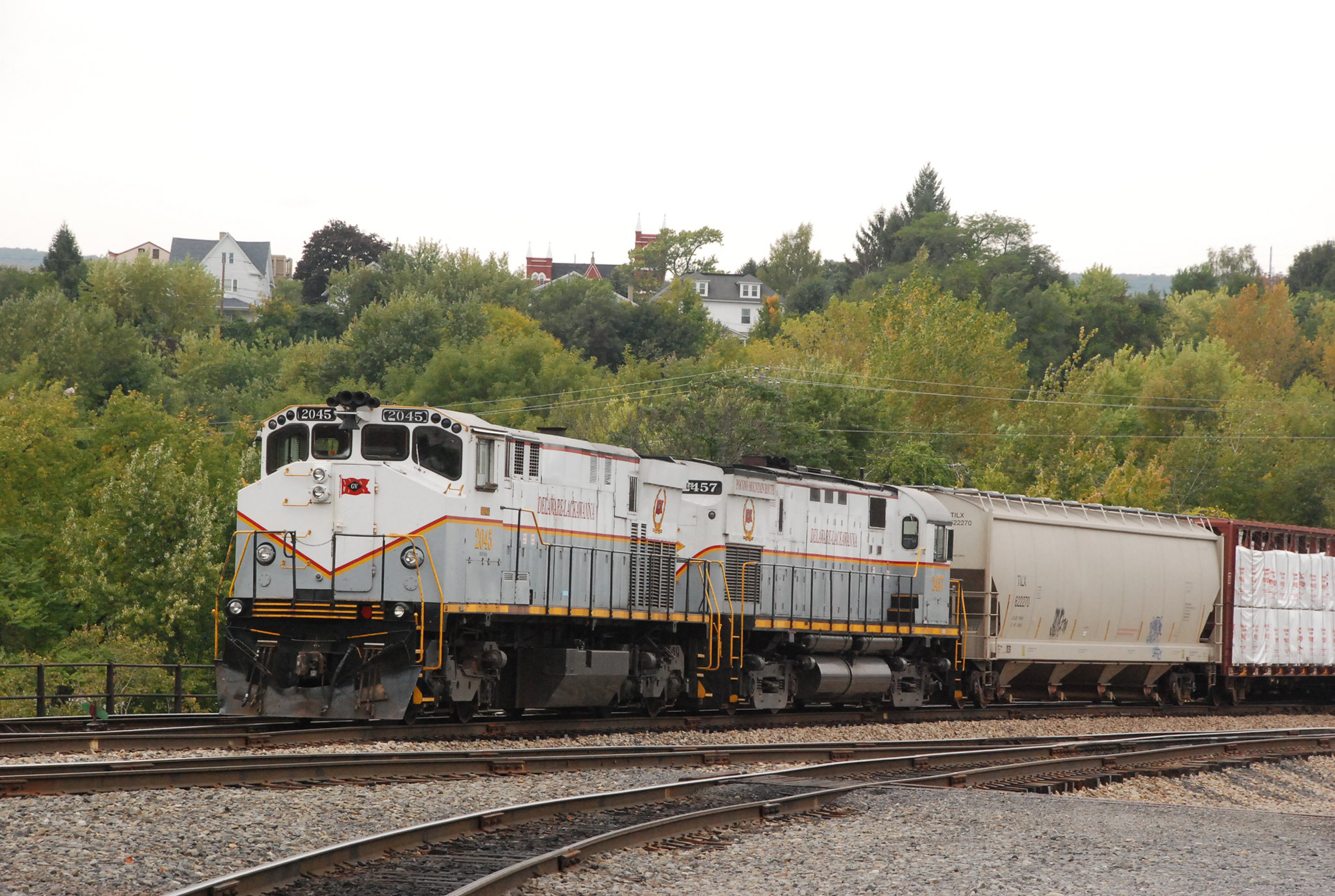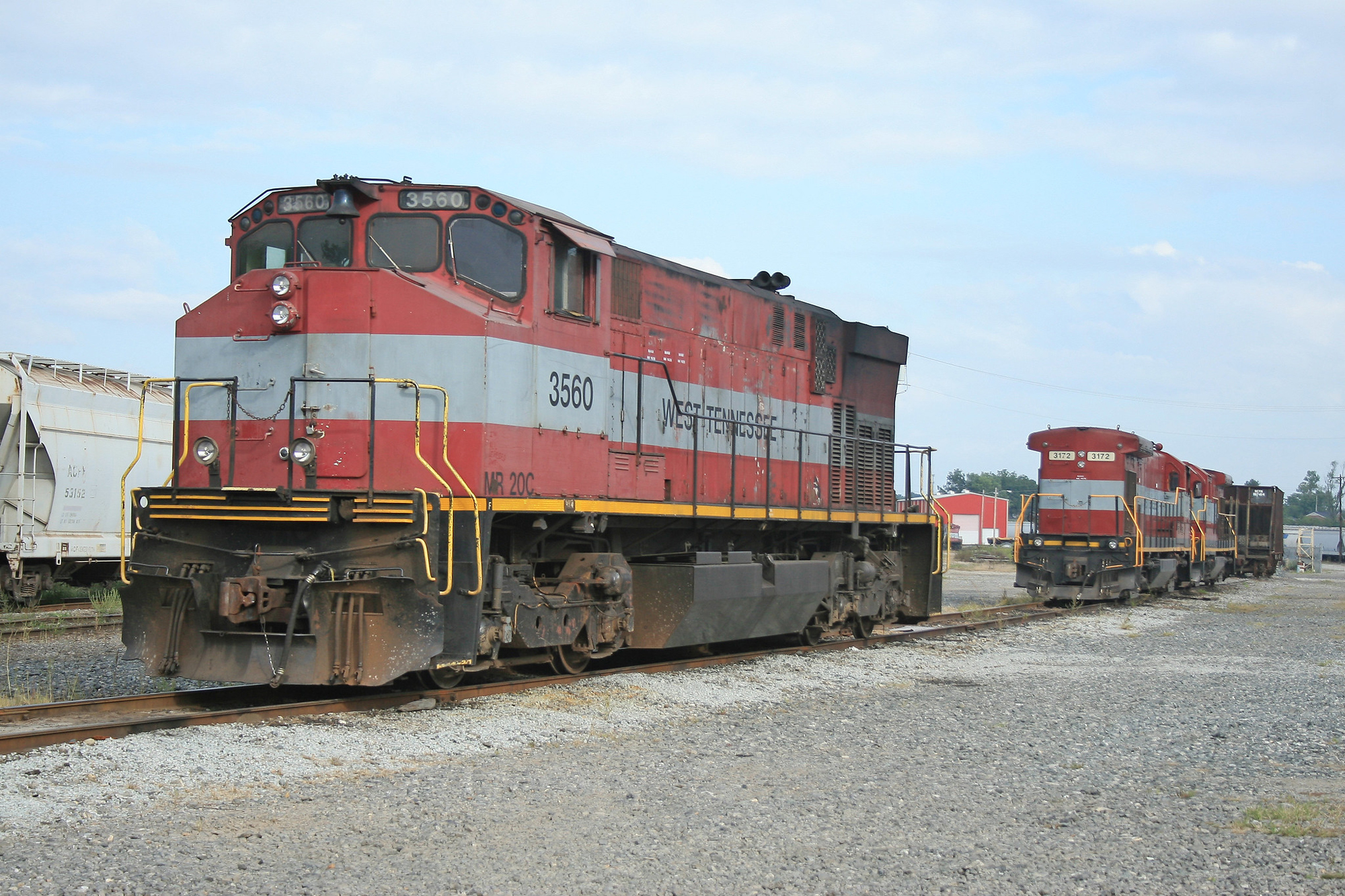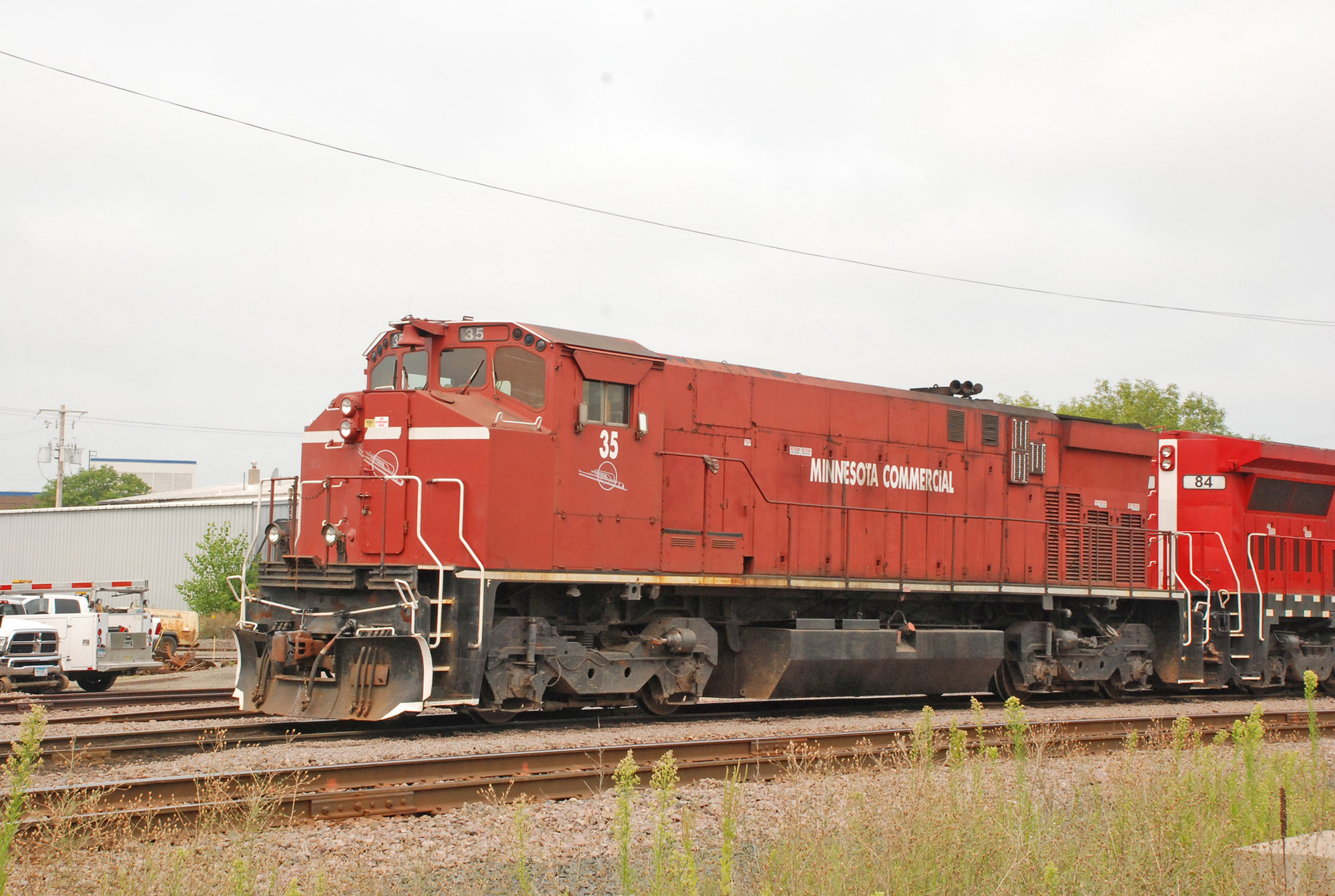MLW "M420" Locomotives: Specs, Roster, History
Published; August 13, 2024
By: Adam Burns
The M420 was produced by the Montreal Locomotive Works (MLW) during the mid-1970s as a continuation of Alco's former C420 line.
The 2,000 horsepower model was a modest success although only 98 were produced between 1973-1977, including a small order of eight cabless "B" units for British Columbia Railway.
The M-420 emerged as a pioneering model in the integration of the wide-nosed Canadian comfort cab, a design innovation spearheaded by Canadian National and shared with units like the GP38-2W, GP40-2W, and GP40-2LW.
By the early 1990s, this cab design had become an industry standard. Locomotives from this era, including General Motors Diesel units, often had a "W" appended to their model names to denote the wide-nose feature, although this was not an official part of the model designation.
 Delaware-Lackawanna M420W #2045 an C425 #2457 are tied down at Scranton, Pennsylvania on the morning of September 24, 2020. Doug Kroll photo.
Delaware-Lackawanna M420W #2045 an C425 #2457 are tied down at Scranton, Pennsylvania on the morning of September 24, 2020. Doug Kroll photo.Historical Context and Development
Montreal Locomotive Works had been manufacturing steam locomotives in Canada since 1883 with the Locomotive & Machine Company of Montreal's establishment that year.
Alco acquired the company in 1904 and renamed it as the Montreal Locomotive Works, Ltd. (MLW) in 1908. It began began producing Alco's diesel catalog in the 1940s and continued to do so even after its parent ceased U.S. production at the end of 1968.
Interestingly, for whatever reason Alco's products were better received in Canada than in the States. The M420, developed between 1973-1977, was part of MLW's attempt to modernize their offerings and remain competitive against larger firms like General Electric and EMD.
Technical Specifications
Central to the M420's identity is its ALCO 251C prime mover — a 12-cylinder, turbocharged diesel engine. This powerplant delivers a robust 2,000 horsepower.
The 251C engine was renowned for its rugged durability and performance - a far better design over the earlier 244 in main line service - and was Alco's primary powerplant in its Century series.
| Attribute | Details |
|---|---|
| Engine Builder | Montreal Locomotive Works |
| Engine | 4-cycle Model 251C (V12) |
| Bore & Stroke | 9" X 10 ½" |
| RPM (Maximum / Minimum) | 1050 / 450 |
| Main Generator | GE GTA17 |
| Horsepower | 2400 |
| Gear Ratio | 74:18 |
| Top Speed | 67 mph |
| Wheel Arrangement | B-B |
| Weight | 272,000 Lbs |
| Traction Motors | GE 752 (4) |
| Tractive Effort (Starting) | 60,400 Lbs at 25% |
| Tractive Effort (Continuous) | 35,000 - 38,000 Lbs at 8 mph. |
| Multiple Unit Capability | Yes |
| Dynamic Braking | Yes |
| Auxilary Generator | GE 553 GY27 |
| Alternator | GE Exciter GY2P7 |
| Air Brake | Westinghouse (26LUM) |
| Compressor | Westinghouse (3CDCL) |
| Exterior Dimensions | |
| Total Length | 61' 0" (M420): 61' 0" (M420R): 60' 0" (M420B) |
| Wheel Diameter | 40" |
| Truck Wheel Base | 9' 4" |
| Height to Top Engine Hood | 15' 6" |
| Height to Top Cab Hood | 14' 10" |
| Cab Width | 10' m4" |
| Top Walkway Width | 9' 8" |
| Walkway Width | 5' 1" |
| Engine Hood Width | 10' 3" |
| Center Bolster | 36' 5" |
| Distance between Truck Centers | 47' 5" (M420): 45' 9" (M420R): 45' 9" (M420B) |
| Minimum Turning Radius | 30 degrees |
| Fuel and Capacities | |
| Fuel Oil | 2500 Gallons |
| Lubricating Oil | 216 Gallons |
| Engine Cooling Water | 260 Gallons |
| Sand Capacity | 56 cubic feet |
| Options | |
|
|
Design and Innovative Features
The M420 was essentially MLW's version of the C420 with a B-B trucks. The locomotive measures approximately 61 feet in length and weighed, on average, 272,000 pounds.
One of the key innovations of the M420 was the use of a wide cab, often called a “comfort cab.” This Canadian design provided better ergonomics and visibility for the crew, addressing safety and comfort concerns that were becoming increasingly important at the time.
The wide cab also featured a short nose, improving the engineer's line of sight - they began to make an appearance in the States in the latter 1980s and have since became the industry standard for their added safety features.
Another significant feature was the Hi-Ad (High Adhesion) truck - sometimes referred to as the "Zero Weight-Transfer" truck - which were engineered to maximize traction through weight distribution and improved suspension systems, reducing wheel slippage during operation. This was particularly advantageous in North America’s varied and often challenging terrain.
 West Tennessee Railroad M420W #3560 (ex CN #2560), along with B23-7s #3172 and #4070, are at Jackson, Tennessee on September 22, 2007. Doug Kroll photo.
West Tennessee Railroad M420W #3560 (ex CN #2560), along with B23-7s #3172 and #4070, are at Jackson, Tennessee on September 22, 2007. Doug Kroll photo.Operational Impact
MLW produced 88 units of the M420, which were primarily sold in Canada; Canadian National was one of the largest operators.
The M420 demonstrated remarkable versatility. On freight duties, the locomotive showcased its ability to haul considerable loads over long distances efficiently. The power generated by the 251C engine, coupled with the Hi-Ad truck design, provided exceptional tractive effort, minimizing the need for multiple units.
Variants and Derivatives
The M-420 family included several notable variants:
- The M-420R, with five units built between 1974 and 1975 for the newly independent Providence & Worcester Railroad (P&W). These used trade-in parts and AAR Type B trucks.
- The M-424, an uprated version of the M-420, featured dynamic brakes and increased power output to 2,400 horsepower, tailored for service in Mexico.
- The M-420TR and its sub-variant, the M-420TR-2, served as switcher locomotives. The M-420TR units were sold to Roberval & Saguenay, while fifteen M-420TR-2 units went to Ferrocarril del Pacífico.
Both variations diverged significantly from the standard M-420 design, featuring a lowered hood, shorter frame, and end-cab configuration, making them uniquely suited to their specific operational roles.
Production Roster (M420 Series)
| Original Owner | Road Numbers | Quantity | Serial Number(s) | Completion Dates |
|---|---|---|---|---|
| British Columbia Railway | 640-647 | 8 | M6068-01 thru M6068-08 | 9/1973-10/1973 |
| Canadian National | 2500-2529 | 30 | M6071-01 thru M6071-30 | 5/1973-10/1973 |
| Canadian National | 2530-2559 | 30 | M6081-01 thru M6081-30 | 3/1974-7/1974 |
| Canadian National | 2560-2579 | 20 | M6092-01 thru M6092-20 | 9/1976-12/1976 |
| F.C. de Venezuela | M001-M002 | 2 | M6097-01 and M6097-02 | 8/1976 |
| British Columbia Railway | 681-688 | 8 | M6088-01 thru M6088-08 | 6/1975-7/1975 |
| Providence & Worcester | 2001-2002 | 2 | M6075-01 and M6075-02 | 2/1974 |
| Providence & Worcester | 2003-2005 | 3 | M6086-01 thru M6086-03 | 4/1975-5/1975 |
| Ferrocaril del Pacifico | 522-536 | 15 | M6089-01 thru M6089-15 | 7/1975-9/1975 |
| Roberval & Saguenay | 26-27 | 2 | M6051-01 and M6051-02 | 4/1972 |
| Ferrocaril del Pacifico | 560-566 | 7 | M6114-01 thru M6114-07 | 7/1980 |
| Ferrocaril del Pacifico | 567-575 | 9 | M6114-61 thru M6114-69 | 5/1981 |
| Ferrocaril Unidos del Sureste | 525-527 | 3 | M6114-70 thru M6114-72 | 8/1981 |
| National de Mexico | 9500-9551 | 52 | M6114-09 thru M6114-60 | 9/1980 |
| National de Mexico | 9552 | 1 | M6114-08 | 7/1980 |
 Minnesota Commercial M420W #35 is outside the shops at St. Paul, Minnesota on August 29, 2015. This unit is the ex-CN #3574. Doug Kroll photo.
Minnesota Commercial M420W #35 is outside the shops at St. Paul, Minnesota on August 29, 2015. This unit is the ex-CN #3574. Doug Kroll photo.Legacy
The M420 series holds a distinct place in railway history due to its embodiment of mid-20th century diesel-electric locomotive advances and its role in the evolution of ergonomic and performance standards.
Some M420 units continue to be operational, including within the U.S. as former Canadian examples have made their way south, serving as a testament to MLW’s engineering prowess and the locomotive’s practical design.
They offer a tangible connection to the pragmatic innovation that characterized much of the mid-to-late 20th century rail industry. Locations where they can still be found in service in the States include Minnesota Commercial and Genesee Valley Transportation's family of shortlines
Recent Articles
-
New Mexico Railroad Museums: A Complete Guide
Apr 23, 25 02:25 PM
The enchanting state of New Mexico, known for its vivid landscapes and rich cultural heritage, is home to a number of fascinating railroad museums. -
New Hampshire Railroad Museums: A Complete Guide
Apr 23, 25 02:11 PM
New Hampshire, known for its breathtaking landscapes, historic towns, and vibrant culture, also boasts a rich railroad history that has been meticulously preserved and celebrated across various museum… -
Minnesota Railroad Museums: A Complete Guide
Apr 22, 25 12:17 PM
The state of Minnesota has always played an important role with the railroad industry, from major cities to agriculture. Today, several museums can be found throughout the state.